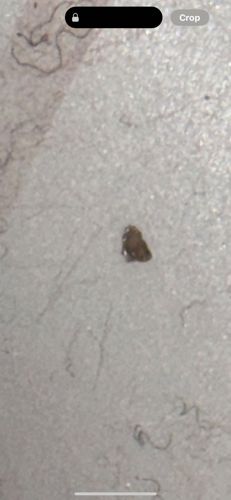Carpet beetle (likely varied carpet beetle or black carpet beetle larva)
Scientific Name: Globally, several species in the family Dermestidae. Common ones include 'Anthrenus verbasci' (varied carpet beetle) or 'Attagenus unicolor' (black carpet beetle). Due to the blurry image, it's hard to be more specific, but the shape suggests a larva.
Order & Family: Order: Coleoptera, Family: Dermestidae
Size: Larvae typically range from 2mm to 5mm (.08 to .2 inches) in length.

Natural Habitat
Indoors, especially in homes and museums. They prefer dark, undisturbed areas such as under carpets, in closets, behind baseboards, and in stored garments or pantry items. Outdoors, they can be found in bird nests, animal carcasses, or dried plant material.
Diet & Feeding
Larvae feed on a wide variety of organic materials, particularly those high in protein. This includes animal products like wool, fur, feathers, silk, leather, dried meats, and pet food. They also consume plant materials like cereals, spices, and dried flowers.
Behavior Patterns
Carpet beetle larvae are typically found in dark, secluded areas where they can feed undisturbed. They molt several times, leaving behind shed skins that can be an indicator of their presence. The larval stage is the damaging stage. Adults are harmless and typically feed on pollen and nectar outdoors.
Risks & Benefits
Risks: Carpet beetle larvae are significant household pests, causing damage to textiles (carpets, clothing, upholstery), museum specimens, and stored foods. They do not bite people, but some individuals may experience skin irritation from contact with their bristles. Benefits: In nature, they play a role in decomposition, feeding on dried animal remains and detritus. However, their indoor presence is almost exclusively considered a pest.
Identified on: 9/15/2025